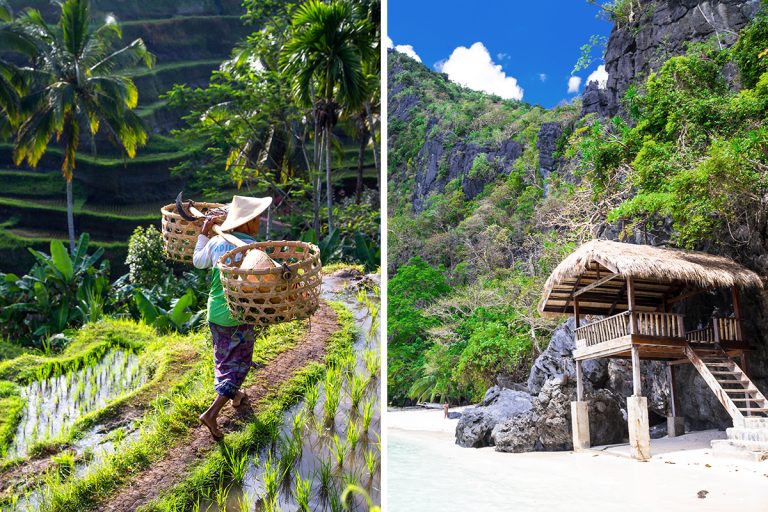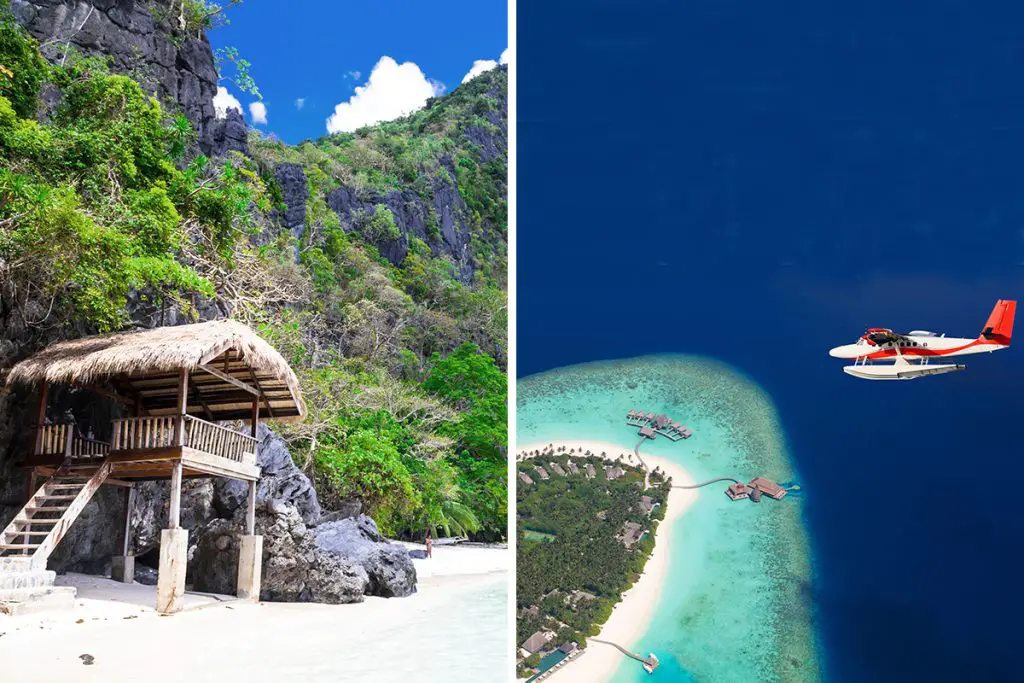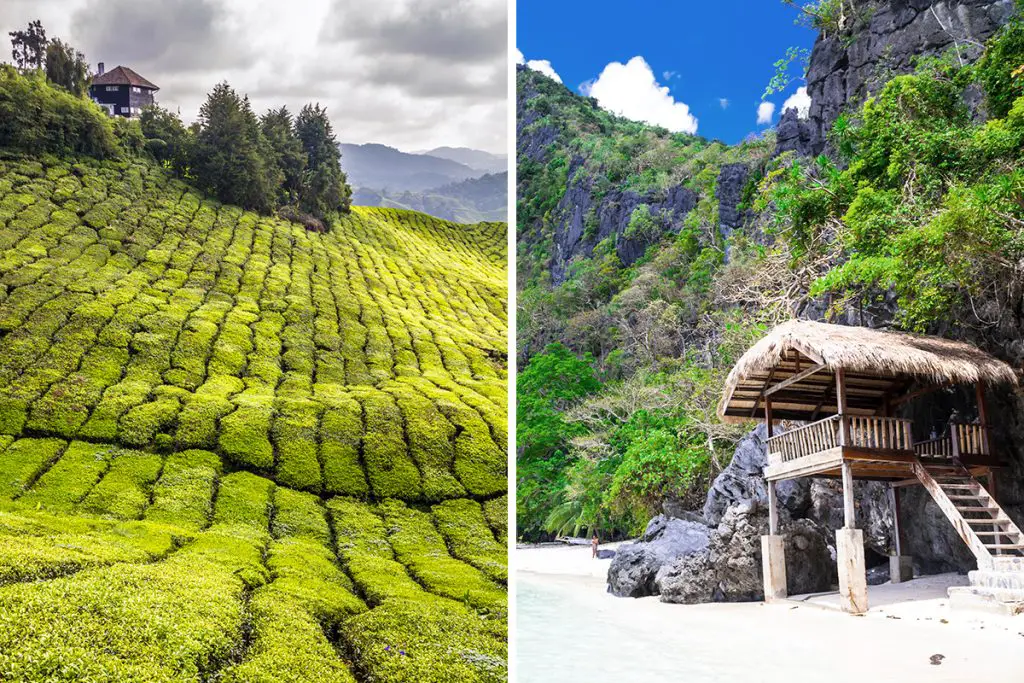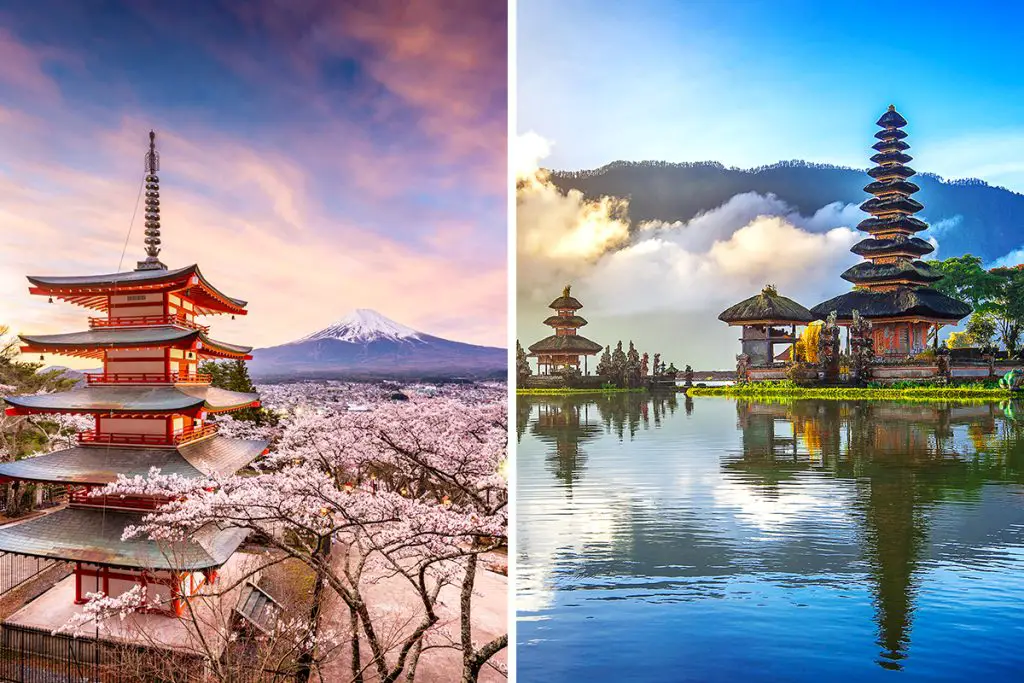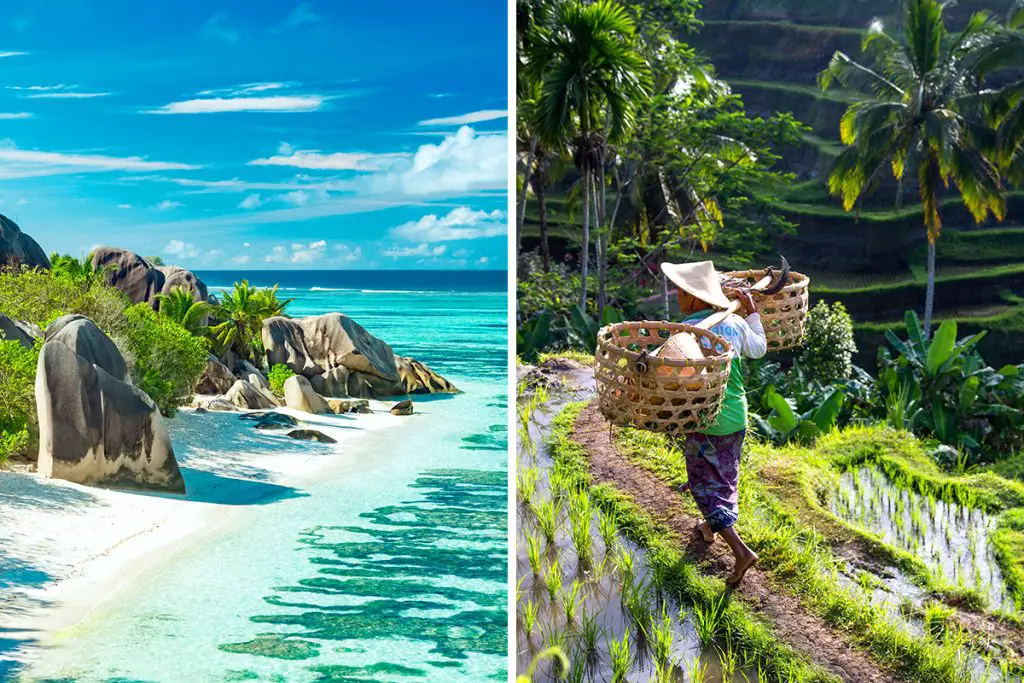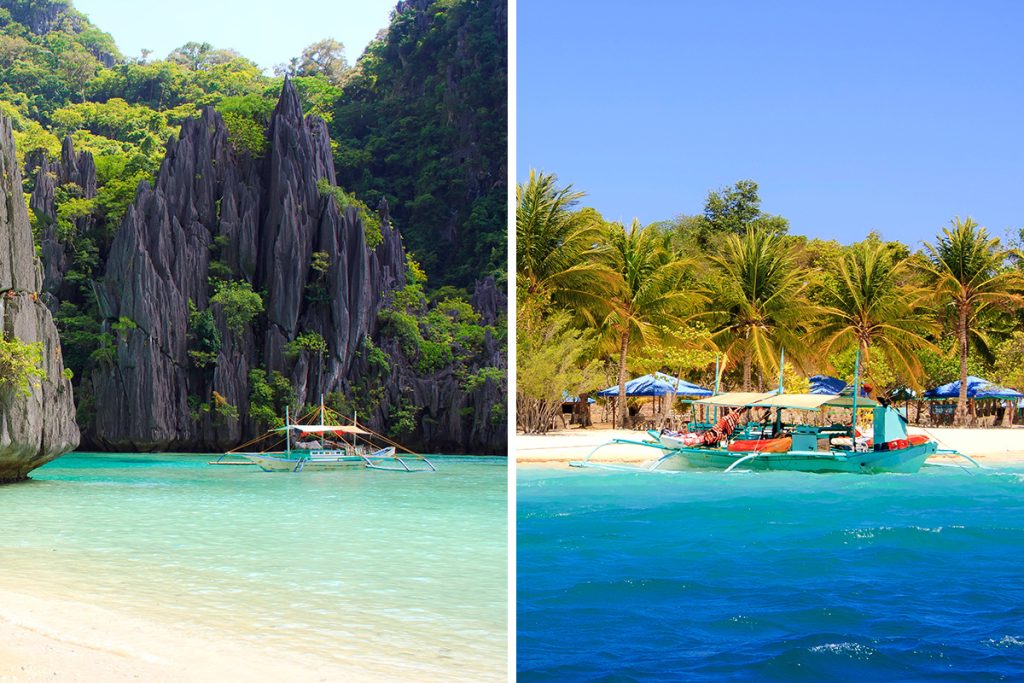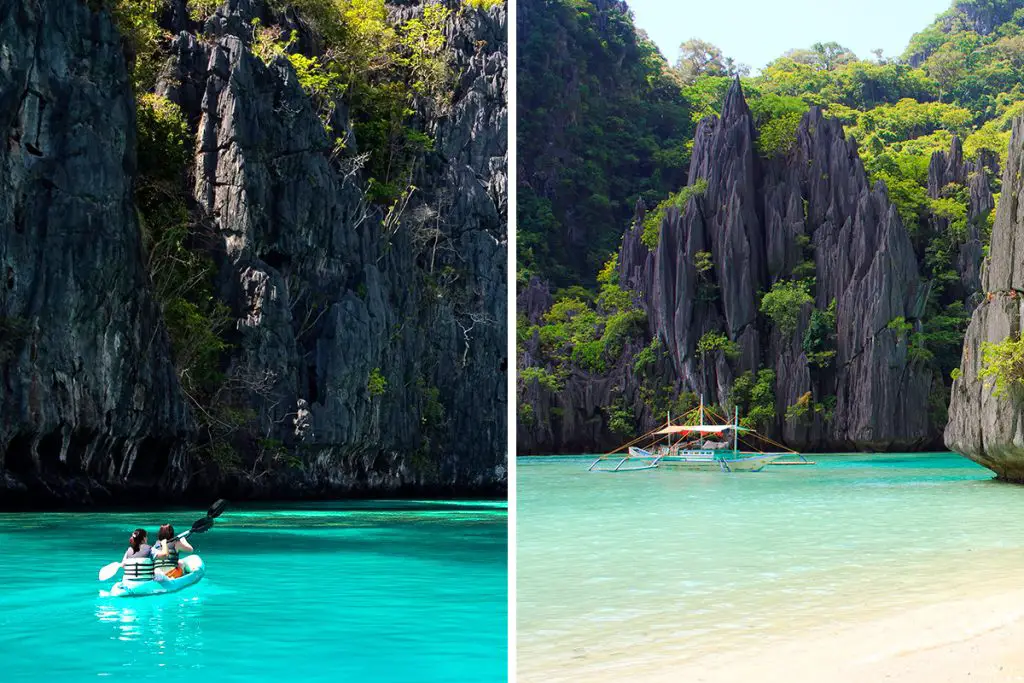Diving into the world of travel, you might be torn between two stunning destinations – Bali, a tranquil paradise in the heart of Indonesia, and the Philippines, an archipelago boasting more than 7,000 islands. Both possess a charm uniquely their own, pulsating with history and vibrant cultures that beckon explorers from every corner of the globe. Read on to discover the distinctive histories and cultures each of these remarkable destinations has to offer.
History & Culture
Unraveling the threads of history and culture between Bali and the Philippines presents an intriguing tapestry of the human story. Both have roots that dive deep into the past, each offering its unique version of historical and cultural richness.
Bali, known as the Island of the Gods, wears its history like a vibrant cloak. The Balinese culture, steeped in Hindu tradition, presents a colorful past, with intricately carved temples and dramatic dances that tell tales of ancient mythology.
You’d be thrilled to see how the Balinese honor their past, with traditions passed down from generations immersing you in a world both mythical and real. Even today, the practices of the past are visible in every aspect of daily life, from the daily offerings to the grand religious ceremonies.
On the other side, the Philippines, fondly referred to as the Pearl of the Orient Seas, boasts a history equally captivating. Shaped by a diverse range of influences, from the native Austronesian roots to the waves of Spanish and American colonial periods, Filipino culture embodies resilience and fusion.
In the Philippines, you’ll witness an intricate blend of indigenous customs and foreign influences, creating a unique cultural melting pot. This robust and diverse history paints a multi-layered portrait of a nation that’s emerged strong and proud.
However, what truly sets these two apart are their unique historical narratives and the ways these stories have shaped their cultures. While Bali’s culture is primarily influenced by its Hindu beliefs and ancient rituals, the Philippines has developed a hybrid culture, reflecting its complex historical journey.
In conclusion, if you’re seeking a destination where you can dive into the wellspring of a unique, deeply-rooted culture, Bali offers a fascinating tapestry of historical and cultural treasures. However, if a diverse cultural blend derived from a rich, multi-layered history is what excites you, then the Philippines will not disappoint. Both destinations provide distinctive historical and cultural experiences, each capable of making your journey an unforgettable adventure.
Attractions & Activities
As you plan your journey, both Bali and the Philippines promise a myriad of thrilling attractions and engaging activities. These destinations, with their natural beauty and distinct charm, offer memorable experiences.
Bali, a haven for nature lovers and culture enthusiasts, boasts an abundance of attractions. The iconic Tanah Lot Temple, standing steadfast against the crashing waves, is a sight to behold. Then there’s the Ubud Monkey Forest, home to a tribe of grey long-tailed macaques. It’s a must-visit for wildlife enthusiasts.
Adventure seekers can hike up Mount Batur, an active volcano, to witness a breathtaking sunrise, or explore the Tegalalang Rice Terraces for a glimpse into the traditional farming methods.
Flip the coin, and the Philippines delivers just as grand an adventure. A trip to the historical city of Intramuros in Manila takes you back in time, surrounded by old Spanish-era architecture. The Chocolate Hills of Bohol, more than a thousand cone-shaped hills stretching as far as your eyes can see, present a surreal landscape.
For an adrenaline rush, you can’t miss out on spelunking in the Sagada Caves or a riveting whitewater rafting experience at Cagayan de Oro.
What’s fascinating is that despite offering similar nature and adventure-based activities, Bali and the Philippines cater to different tastes. While Bali is more about cultural immersion and serene landscapes, the Philippines stands out with its vibrant historical spots and pulse-pounding adventure opportunities.
In essence, both Bali and the Philippines cater to a wide array of interests. Whether you’re a nature buff, a history enthusiast, or an adrenaline junkie, both destinations offer unique attractions and activities to create unforgettable travel memories.
Beaches
The beauty of the beach is a prime allure for any tropical destination. Comparing the beaches of Bali and the Philippines will reveal the extraordinary coastal wonders each has to offer.
In Bali, the beaches paint a diverse palette. Seminyak Beach, for example, features golden sand and azure waters, spanning roughly 3.1 miles (5 kilometers). For surfers, the high rolling waves of Uluwatu beach, which extends approximately 0.62 miles (1 kilometer), are hard to resist.
Meanwhile, the seclusion of Pasir Putih, also known as Virgin Beach, provides the perfect escape for those seeking tranquility.
On the other hand, the Philippines, with its expansive archipelago, is home to numerous idyllic beaches.
Boracay’s White Beach, about 2.5 miles (4 kilometers) long, is famous for its powdery white sand and serene blue waters. El Nido in Palawan offers a stunning variety of beaches, each with unique features. Among them, Nacpan Beach, with its stretch of about 2.8 miles (4.5 kilometers), is widely celebrated for its untouched beauty.
While Bali’s beaches impress with their varied characteristics, from lively surf spots to tranquil coves, the Philippines boasts an array of pristine, world-class beaches spread across its many islands. Each presents a unique take on the quintessential tropical beach experience.
In summary, whether you’re drawn to Bali’s diverse beach landscapes or the Philippines’ vast array of pristine coastlines, both destinations are sure to satisfy your longing for a remarkable beach getaway.
Eating, Drinking & Nightlife
The sensory pleasures of eating, drinking, and experiencing the nightlife form an integral part of the travel experience. Both Bali and the Philippines present a world of flavors and vibes worth exploring.
Bali’s food scene is a delightful fusion of local and international flavors. Traditional Balinese dishes like Nasi Campur and Satay will delight your palate. For a unique drinking experience, Bali offers a variety of local beverages such as Bintang, a popular Indonesian beer, and Arak, a traditional Balinese liquor.
In contrast, the Philippines offers a wide array of gastronomical delights that reflect its rich, cultural heritage. Lechon, a whole roasted pig, and Adobo, a flavorful stew, are iconic Filipino dishes. For drinks, San Miguel Beer is a popular choice, while the local coconut wine called Tuba offers a taste of the country’s tropical charm.
Nightlife in Bali varies greatly from beach clubs to traditional performances. Seminyak and Kuta are home to chic beach clubs where you can dance to the rhythm of crashing waves. Alternatively, you can enjoy traditional performances such as Kecak and Legong dance in Ubud.
Meanwhile, the Philippines delivers an equally vibrant nightlife. Manila’s nightlife districts like Makati and Bonifacio Global City are brimming with bustling bars and clubs. For a unique experience, traditional folk music performances in Intramuros offer soulful nighttime entertainment.
In a nutshell, whether it’s for the diverse culinary options, unique drinks, or vibrant nightlife, both Bali and the Philippines offer a myriad of choices that cater to every taste and preference.
Shopping
In addition to breathtaking attractions and vibrant nightlife, shopping experiences also contribute to a memorable journey. Bali and the Philippines each offer unique shopping experiences that can bring joy to any traveler.
In Bali, the Ubud Art Market is a treasure trove of unique handcrafted goods, paintings, and silk scarves. Another popular spot is the Sukawati Market, known for its collection of traditional Balinese artwork and crafts. Shoppers can indulge in retail therapy while also gaining insight into Bali’s artistic heritage.
The Philippines, on the other hand, offers a different flavor of shopping. Greenhills Shopping Center in Manila is famed for its vast selection of pearls and jewelry. If you’re looking for local handicrafts, the Baguio City Market offers an array of handwoven items and wood-carved artifacts.
Despite their differences, both destinations provide unique shopping experiences. Bali stands out for its focus on local arts and crafts, while the Philippines offers a blend of cultural artifacts and modern goods.
In summary, whether you prefer exploring the artistic markets of Bali or the diverse shops of the Philippines, you’re in for a rewarding shopping adventure.
Accommodation
When it comes to accommodation, both Bali and the Philippines offer a wide range of options catering to various budgets and preferences.
In Bali, there’s an eclectic mix of accommodations to suit every type of traveler.
For luxury seekers, the lavish beachfront resorts in Seminyak, such as the Samaya and Anantara, offer top-notch amenities. Ubud is famed for its boutique hotels like the Hanging Gardens, set amidst lush jungles and rice fields. For budget travelers, Kuta and Legian host numerous affordable guesthouses and hostels.
On the other hand, the Philippines’ accommodation scene is equally varied.
Metro Manila offers a host of luxury hotels like the Shangri-La and the Peninsula. The island of Boracay is home to a mix of high-end resorts like Shangri-La’s Boracay Resort and budget-friendly hostels. In Palawan, there’s an array of beachfront cottages and budget guesthouses, perfect for those seeking a laid-back island experience.
Whether you’re looking for luxury, comfort, or affordability, both Bali and the Philippines cater to your accommodation needs. The destinations offer a diverse range of options, from high-end resorts to budget-friendly hostels, ensuring a comfortable stay.
Family-Friendliness & Children’s Activities
A family vacation should be memorable for all, and both Bali and the Philippines make this possible with their family-friendly environments and child-centered activities.
In Bali, families can explore the Bali Safari and Marine Park, where children can get up close to various wildlife. The Waterbom Bali, filled with exciting water slides, is a hit among kids. Additionally, most resorts in Bali offer kid-friendly amenities and activities, making it easy for families to enjoy their stay.
On the flip side, the Philippines also has a plethora of activities for children. Manila Ocean Park is a marine-themed park that offers various interactive exhibits. Kids will love the interactive exhibits at the Mind Museum in Taguig. Additionally, the country’s family-friendly resorts often feature kid’s clubs and activities tailored to entertain the young ones.
Whether it’s the educational and adventure activities in Bali or the interactive fun in the Philippines, both destinations are brimming with family-friendly activities. Each offers a blend of learning and fun, making them ideal for a family getaway.
Getting There & Getting Around
Traveling to and navigating within a foreign country can be a vital aspect of your journey. Both Bali and the Philippines provide a range of options to suit different travel preferences.
To reach Bali, international flights usually land at Ngurah Rai International Airport, which is about 8.1 miles (13 kilometers) south of Denpasar, the capital city.
In contrast, the Philippines, being an archipelago, has several international airports. The Ninoy Aquino International Airport in Manila is the primary gateway, with others like Mactan-Cebu International Airport serving as alternative entry points.
Once you’re in Bali, you can opt for taxis, hire drivers, or rent a motorbike to explore the island. Be aware, though, that Bali does not have a comprehensive public transport system.
The Philippines, on the other hand, has a more varied mix of public transport including Jeepneys, tricycles, taxis, and buses. For inter-island travel, domestic flights, ferries, and bangkas (local outrigger boats) are commonly used.
In summary, getting to and around both Bali and the Philippines can be a breeze with proper planning. Each destination offers a variety of transport options, catering to different budgets and travel styles, ensuring a smooth travel experience.
Weather
Weather plays a crucial role in planning a vacation. Let’s compare the climates of Bali and the Philippines to help you decide on the best time to visit.
Bali, located near the equator, enjoys a tropical climate. It’s warm all year round, with temperatures usually hovering between 68°F and 89°F (20°C and 32°C). There are two main seasons: the dry season from May to September and the wet season from October to April. The dry season is the most popular time to visit Bali.
The Philippines also has a tropical climate, with temperatures generally between 70°F and 93°F (21°C and 34°C). It has three main seasons: the hot dry season from March to May, the rainy season from June to November, and the cool dry season from December to February. Most people prefer visiting during the cool dry season, as the weather is pleasant and rainfall is minimal.
In essence, whether you’re planning to visit Bali or the Philippines, understanding their weather patterns will ensure you make the most of your trip.
Safety
Safety is always a concern when planning a trip. Let’s look at how safe Bali and the Philippines are for tourists.
Bali is generally safe for tourists, with common issues being minor thefts like pickpocketing in crowded areas. It’s important to remain aware of your surroundings, especially in tourist hotspots.
In the Philippines, safety can vary depending on the area. Urban areas like Manila have higher crime rates compared to rural areas or smaller islands. Tourists should be cautious in crowded places and avoid less safe areas.
Besides crime, another safety concern is natural disasters. Both Bali and the Philippines experience natural events such as earthquakes and typhoons. It’s always a good idea to keep updated on weather forecasts and advisories during your stay.
In a nutshell, both Bali and the Philippines require some level of caution, as would any travel destination. Staying informed and being aware of your surroundings can go a long way in ensuring your trip is a safe one.
Cost
Traveling costs can greatly influence your trip, so let’s compare the costs in Bali and the Philippines.
Bali is known for its affordability. Accommodation can range from 200,000 Rupiah (14 USD) per night for budget guesthouses to over 3,000,000 Rupiah (210 USD) for luxury resorts. Meals at local warungs (small family-owned businesses) can be as low as 15,000 Rupiah (1 USD), while upscale dining can go over 200,000 Rupiah (14 USD).
The Philippines is also budget-friendly. Accommodation can range from 500 Pesos (10 USD) per night in budget inns to over 5,000 Pesos (100 USD) in luxury resorts. Meals at local eateries can be as low as 50 Pesos (1 USD), with fine dining at high-end restaurants costing above 1,000 Pesos (20 USD).
To sum up, both Bali and the Philippines offer good value for money, with options to suit various budgets. Being mindful of your expenses can ensure a memorable trip without breaking the bank.
Which Is Better – Bali or the Philippines?
Traveling is an enriching experience, and choosing between Bali and the Philippines can be a tough decision. Both offer diverse histories, intriguing cultures, unforgettable attractions, and stunning landscapes. Let’s delve into a comparative summary of these two destinations.
History and culture are the souls of any destination. Bali, with its unique blend of Hindu culture, ancient temples, and traditional ceremonies, offers a distinctive cultural immersion.
The Philippines, with its Spanish-influenced architecture, rich tribal cultures, and vibrant festivals, provides a diverse cultural tapestry. Both offer deep historical roots and captivating cultures, each unique in their own right.
In terms of attractions and activities, both destinations excel. Bali is known for its iconic temples, picturesque rice terraces, and yoga retreats, perfect for those seeking spirituality and tranquility. On the other hand, the Philippines, with its diverse wildlife, extensive hiking trails, and historic landmarks, is a haven for adventurers and history enthusiasts.
Bali and the Philippines both offer extraordinary beach experiences. Bali’s beaches are renowned for their surf waves and beautiful sunsets, while the Philippines is famous for its pristine white sand beaches and crystal clear waters. The choice between the two comes down to personal preference.
The dining scenes in both destinations cater to all taste buds. Bali stands out for its healthy food options and trendy beachfront dining spots. Meanwhile, the Philippines impresses with its unique blend of local and Spanish-influenced cuisines. Both destinations offer vibrant nightlife, with Bali being more relaxed and the Philippines more dynamic.
Shopping in Bali and the Philippines is a unique experience. Bali is famous for its artisanal crafts and traditional markets, while the Philippines offers a mix of local and international shopping experiences. Both have a variety of accommodation options, from budget-friendly to luxury, catering to all types of travelers.
Finally, both destinations are family-friendly with numerous activities for children. However, getting to and around Bali is more straightforward due to its smaller size, while the Philippines, being an archipelago, might require more planning. The weather in both locations is generally warm, with different seasons offering unique experiences.
Safety is a priority in both destinations, with standard precautions needed. Cost-wise, both are affordable with options to fit all budgets.
In conclusion, the choice between Bali and the Philippines will depend on your travel preferences. If you are looking for spiritual enrichment, wellness retreats, and artisanal shopping, Bali is your destination. However, if you desire adventurous activities, diverse cultural experiences, and island hopping, the Philippines awaits. Ultimately, whether you choose Bali or the Philippines, an enriching and unforgettable travel experience is guaranteed.

